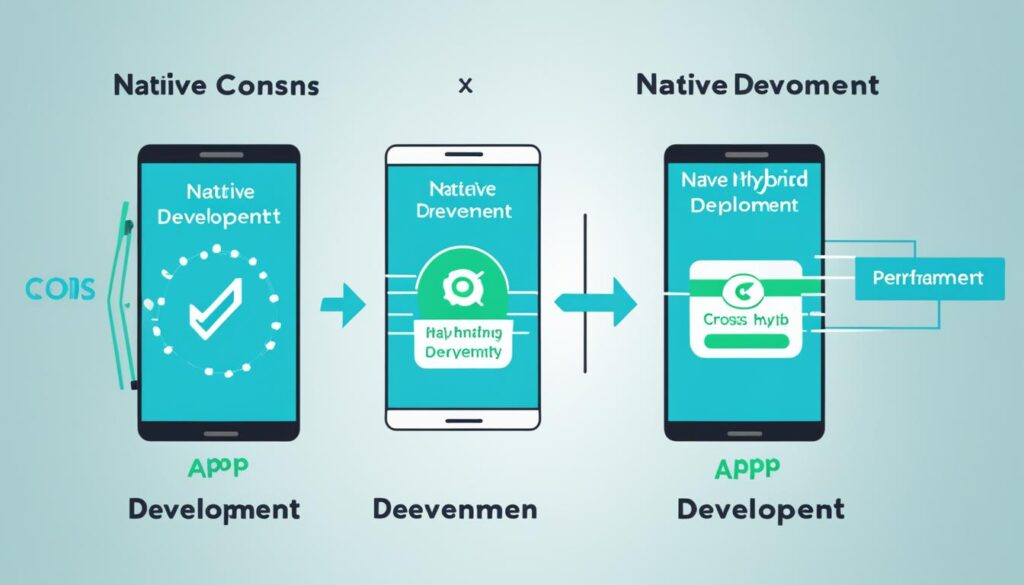Choosing the right technology for your mobile app is crucial. It can greatly affect your app’s success. This guide will give you key tips to pick the best technology for your project. This ensures your app works well, grows, and gives a great user experience.
Table of Contents
Key Takeaways
- Understand your app’s requirements and identify its core purpose and features
- Consider user experience and usability as key factors in technology selection
- Evaluate the pros and cons of native, hybrid, and cross-platform development approaches
- Assess the performance, security, and scalability of different mobile app development technologies
- Ensure the selected technology aligns with your development team’s expertise and budget
Understand Your App’s Requirements
Creating a successful mobile app begins with knowing what it needs. You must understand its purpose, key features, and what your audience wants. This helps you pick the best technology for your app.
Identify App’s Purpose and Features
Start by defining your app’s main goal. Is it for fun, to make life easier, or to solve a problem? List the main features that will meet this goal. Think about what your app must do, like storing data or working offline.
Consider User Experience and Usability
Make sure your app focuses on the user. Think about what your audience likes and needs. Make sure your app is easy to use and fun. Also, think about how fast and accessible it is to make it better for everyone.
“Successful mobile apps are built with a deep understanding of their target audience and their unique needs.”
By thinking about what your app needs, you can pick the right technology. This is key for your app’s success.
Native vs. Hybrid vs. Cross-Platform Development
Choosing the right approach for mobile app development is key. You have to decide between native app development, hybrid app development, or cross-platform development. Each method has its own pros and cons regarding performance, platform-specific features, development cost, and time-to-market.
Native app development means making an app for just one mobile system, like iOS or Android. This makes the app run smoothly and use all the special features of the platform. But, it can be more expensive and take longer because you need to create different code for each platform.
Hybrid app development blends web tech (HTML, CSS, JavaScript) with native parts to make one app for many platforms. This can save money and time, but the app might not work as well as a native app. It also might not have full access to some special features of the platform.
Then, there’s cross-platform development with frameworks like React Native or Flutter. These let you write one code that works on both iOS and Android. This method tries to balance performance, special features, development cost, and time-to-market.
| Approach | Performance | Platform-Specific Features | Development Cost | Time-to-Market |
|---|---|---|---|---|
| Native App Development | High | Full access | High | High |
| Hybrid App Development | Medium | Limited access | Low | Low |
| Cross-Platform Development | Medium-High | Partial access | Medium | Medium |
It’s important to weigh the pros and cons of each approach to find the best one for your app’s needs and goals.
Popular Mobile App Development Technologies
There are many technologies for making mobile apps, each with its own strengths. For iOS, Swift and Objective-C are the main choices. Swift, introduced in 2014, is modern, fast, and safe. It’s popular among iOS developers. Objective-C, the original iOS language, is still widely used.
iOS Development Technologies
For Android, Java and Kotlin are the top languages. Java has been key since Android started. Kotlin, introduced by Google in 2017, is a modern choice.
Android Development Technologies
Cross-platform frameworks like React Native, Flutter, and Xamarin are also popular. They let developers make apps for both iOS and Android with one codebase. This makes them great for businesses wanting to reach more people.
| Technology | Key Features | Pros | Cons |
|---|---|---|---|
| Swift | Modern, fast, and secure programming language for iOS development | Concise and expressive syntax, seamless integration with Apple’s ecosystem, strong performance | Limited to iOS platform, requires learning a new language for developers familiar with Objective-C |
| Objective-C | Original programming language for iOS development, with a C-based syntax | Mature and well-documented, widely used in the iOS ecosystem | Considered less modern and more verbose compared to Swift, steeper learning curve |
| Java | Long-standing programming language for Android development, with a robust ecosystem | Widely used, large developer community, extensive libraries and tools | Can be more verbose and complex compared to Kotlin, requires more boilerplate code |
| Kotlin | Modern, concise, and type-safe programming language for Android development | Expressive syntax, interoperability with Java, improved developer productivity | Relatively newer language, smaller ecosystem compared to Java |
| React Native | Cross-platform framework that allows building native mobile apps using JavaScript and React | Write once, run on both iOS and Android, leverage existing web development skills | Performance can be challenging for complex apps, limited access to platform-specific features |
| Flutter | Google’s open-source cross-platform framework for building natively compiled applications | Fast development, high-performance, access to platform-specific features | Relatively new ecosystem, limited availability of third-party libraries compared to other frameworks |
| Xamarin | Microsoft’s cross-platform framework for building native mobile apps using C# and .NET | Consistent user experience across platforms, code sharing between iOS and Android | Steep learning curve for developers not familiar with C# and .NET, potentially higher development costs |
Knowing about these popular mobile app development technologies can help you choose the best one for your project.
Factors to Consider When Choosing Mobile App Technology
When picking a mobile app development tech, think about a few key things. Making sure your app works well and fast is key. Users want smooth and quick experiences. Also, keeping user info safe and private is very important to gain trust.
Performance and Speed
The tech you choose must deliver great app performance and speed. It should handle the app’s features without slowing down the user. Things like how fast it processes info, manages memory, and uses the network are crucial for speed and performance.
Security and Privacy
Today, keeping apps safe and private is a top priority. The tech you pick must have strong security to protect user data. Things like encryption, secure login, and safe data storage are key.
Also, the tech should grow with your app. It should work well with other services for future updates and new features. This way, your app can keep up with changing user needs and stay competitive.
“Selecting the right mobile app development technology is crucial for the success and longevity of your app. It’s not just about the features, but the underlying capabilities that enable seamless performance, security, and scalability.”
Tips to choose correct technology for mobile app development
Choosing the right technology for your mobile app is key to its success. Here are some tips to help you make the right choice:
- Define Your App’s Requirements and Objectives: First, understand what your app is for, who will use it, and what it needs to do. This will guide you in picking the right tech, like how fast it should work, how big it can grow, and how easy it is for users.
- Evaluate the Strengths and Weaknesses of Different Technologies: Look at the different ways to make apps, like native, hybrid, and cross-platform. See how each one stacks up in terms of cost, how fast you can get it out there, and how easy it is to keep up with updates.
- Consider Your Target Audience and Device Preferences: Know what devices and preferences your users have. This will help you pick the best tech that meets their needs and gives them a great experience.
- Analyze the Development Team’s Expertise: Check the skills and experience of your team. Pick a technology that fits their strengths and what they’re good at.
- Plan for Long-Term Maintenance and Updates: Make sure the tech you choose can handle updates and grow with your app. This saves you from having to switch tech later, which can be expensive and time-consuming.
By carefully evaluating your options, you can find the technology that’s best for your app and sets it up for success.
“The right technology can make or break your mobile app project. Choose wisely and set your app up for long-term success.”
Scalability and Future Growth
Choosing the right technology for your mobile app is key to its growth. It must handle more users, more traffic, and new features smoothly. This way, your app can grow with your business and changing needs.
For your app’s long-term success, focus on technologies that offer:
- App Scalability: The ability to handle more users and traffic without slowing down.
- Technology Scalability: The flexibility to add new features and adapt to market changes.
- Platform Expansion: The chance to reach more users by adding to iOS and Android without a full rebuild.
Choosing scalable technology means your app can grow and stay competitive. You can improve the user experience, add new features, and keep up with the competition.
| Feature | Importance for Scalability |
|---|---|
| Modular Architecture | Enables easy addition of new features and functionalities without disrupting the core app. |
| Cloud-Based Infrastructure | Provides the flexibility to scale computing resources up or down based on user demands. |
| Microservices Design | Allows for independent scaling of individual app components, improving overall scalability. |
| Automated Deployment | Facilitates seamless and efficient rollout of updates and new features. |
“Scalability is not just about handling more users or traffic; it’s about building a robust and adaptable app that can evolve with your business.” – Technology Consultant
Development Cost and Time-to-Market
Choosing the right mobile app development technology is key. It affects your project’s development cost and time-to-market. These factors depend on your development team’s expertise and the technology learning curve needed for your project.
Development Team Expertise
Your development team’s skills are crucial when picking a mobile app technology. If they’re experts in iOS or Android, you can use their skills to cut down on the technology learning curve. This might also lower the development cost. But, if they’re new to the tech, they’ll need more time and resources to learn. This could push back the time-to-market and increase the development cost.
When looking at mobile app development technologies, think about the availability of skilled developers. Check if they’re in your area or part of your team. This helps you see if your project is feasible and what resources you’ll need. It makes the development smoother and helps you estimate the development cost and time-to-market better.
| Technology | Development Cost | Time-to-Market | Expertise Level |
|---|---|---|---|
| Native iOS | High | Moderate | High |
| Native Android | High | Moderate | High |
| Cross-Platform (e.g., React Native, Flutter) | Moderate | Fast | Moderate |
| Hybrid (e.g., Cordova, Ionic) | Low | Fast | Low |
The table shows a comparison of different mobile app development technologies. It looks at development cost, time-to-market, and the expertise level needed. Remember, the actual costs and timelines can change based on your project’s details and your team’s skills.
Integration with Third-Party Services
In today’s fast-paced mobile app world, it’s key to work well with third-party services, APIs, and data sources. These partnerships can make your app more useful and appealing to users. They add more to what your app can do.
When picking a tech for your app, focus on ones that are great at integration. Look for features like:
- Easy API connections to many backend services and cloud-based platforms.
- Good software development kits (SDKs) that make adding features easier.
- The ability to use different data sources to make your app more personal and useful.
Choosing tech that’s strong in third-party integration opens up many possibilities for your app. Using outside services and data can make your app better for users. It can also make people more likely to keep using it.
“The ability to seamlessly integrate with third-party services is a game-changer in mobile app development, unlocking new levels of functionality and user value.”
When looking at tech for your app, make sure it’s good at third-party integration. This choice can help your app succeed in the changing mobile world.
Testing and Quality Assurance
Testing and quality assurance are key in mobile app development. They make sure the app works well for users. The tech you pick should have strong testing features. This includes app testing, quality assurance, and automated testing.
It’s important to have built-in testing frameworks and automated testing tools. These tools make testing easier. They help find and fix problems with performance, security, and user experience early on.
Automated Testing Tools
Choose mobile app development tech with automated testing options. This includes:
- Performance testing to check how fast and responsive the app is under heavy use
- Security testing to find and fix security issues, like data protection and user access control
- User acceptance testing to make sure the app does what users expect
| Testing Type | Description | Benefits |
|---|---|---|
| Performance Testing | Checks how fast, responsive, and scalable the app is under different loads. | Ensures the app works well even with lots of users, giving a smooth experience. |
| Security Testing | Finds and fixes security risks, like data encryption and user access control. | Keeps user data safe and stops unauthorized access or data breaches. |
| User Acceptance Testing | Confirms the app meets user needs and expectations. | Increases user happiness and lowers the chance of problems after launch. |
Choosing a mobile app development tech with strong app testing and quality assurance helps. You can make a high-quality, error-free app that meets user needs.
User Engagement and Retention
Choosing the right mobile app development technology is key. It must boost user engagement and user retention. The tech should have strong app analytics to understand what users like and do. This helps you make smart updates that keep users interested and coming back.
Find technologies that work well with top-notch performance optimization tools. These tools help you keep your app fast and smooth. This makes sure users stay happy and keep using your app.
Being able to easily add new features is important too. The best tech lets you quickly add new stuff, listen to user feedback, and keep up with trends. This keeps your app fresh and competitive in a fast-changing market.
| Feature | Importance for User Engagement and Retention |
|---|---|
| Robust App Analytics | Enables deep understanding of user behavior and preferences, informing feature updates and performance optimization. |
| Advanced Performance Optimization Tools | Ensures a fast, responsive, and seamless user experience, keeping users engaged and satisfied. |
| Flexible Feature Updates | Allows you to quickly adapt to user needs and market trends, retaining your user base and staying competitive. |
By looking closely at mobile app development tech, you can pick the best for user engagement and user retention. This ensures your app does well over time and builds a loyal user base.
Platform-Specific Guidelines and Compliance
Choosing the right mobile app development technology is key. It must match the platform’s rules and standards. This means following app store policies, keeping up with user privacy and security standards, and meeting regulatory requirements. Picking a technology that fits these rules makes submitting and getting your app approved easier.
Platforms like iOS and Android have strict platform guidelines for apps. Not following these can lead to your app being rejected or delayed. It’s important to know and follow these rules for a successful launch.
Apps also need to meet many regulatory requirements, like data privacy laws and content rules. Choosing a technology that makes following these easier can save time and money during development.
When picking a technology, don’t forget about user privacy and security standards. Make sure the technology protects data well and follows privacy laws. This builds trust with your users and keeps your business safe from legal and reputation problems.
| Compliance Requirement | Key Considerations |
|---|---|
| App Store Policies |
|
| User Privacy |
|
| Security Standards |
|
| Regulatory Requirements |
|
By matching your app’s technology with the platform’s rules and standards, you can make the submission and approval process smoother. You’ll also protect your users’ privacy and security, and make sure your app meets all the laws.
Maintenance and Updates
Choosing the right mobile app development technology means thinking about maintenance and updates. Look for tech that makes over-the-air (OTA) updates easy. This lets you quickly add bug fixes, feature enhancements, and user experience improvements without hassle. It keeps your app competitive and fresh.
Over-the-Air (OTA) Updates
OTA updates change the game in app maintenance and app updates. They let you update your app without users having to do anything. This means your users get the newest features and improvements right away, making their experience better.
- Seamless bug fixes and feature enhancements
- Improved user experience and customer satisfaction
- Reduced app update friction and user churn
- Faster response to market changes and user feedback
Choosing a tech stack that supports OTA updates keeps your app exciting and competitive. It lets you quickly meet user needs and market trends. This keeps your app a top pick for your audience.
“Embracing technologies that enable seamless over-the-air updates is crucial for maintaining a thriving and continuously improving mobile app.”
| Feature | Benefit |
|---|---|
| App Maintenance | Streamlined process for pushing bug fixes and feature enhancements |
| User Experience Improvements | Enhance app functionality and keep users engaged with the latest updates |
| Reduced Update Friction | Seamless over-the-air updates that minimize user disruption |
Emerging Technologies and Trends
The world of mobile app development is always changing. It’s key to keep up with the newest emerging technologies. Things like 5G, augmented reality (AR), artificial intelligence (AI), and the Internet of Things (IoT) will change how we make mobile apps.
Adding these emerging technologies to your app can make it better and keep you ahead. For instance, 5G’s fast speeds make your app run smoother. AR and AI add cool, smart features that make users more engaged.
As trends in mobile app development change, picking the right tech stack is key. This means choosing tech that can grow with new innovations. By doing this, your app stays fresh and competitive in the fast-changing mobile world.
“The future of mobile apps lies in the convergence of cutting-edge technologies that redefine user experiences and drive innovation.”
Staying updated on new tech helps you make smart choices for your app. This way, your app stays ready for the future and can succeed for a long time.
| Emerging Technology | Impact on Mobile App Development |
|---|---|
| 5G | Improved app performance, lower latency, and enhanced user experiences |
| Augmented Reality (AR) | More immersive and interactive app features, blending digital and physical worlds |
| Artificial Intelligence (AI) | Personalized user experiences, intelligent app capabilities, and automation |
| Internet of Things (IoT) | Seamless integration between mobile apps and connected devices, enabling new use cases |
Conclusion
Choosing the right technology for your mobile app is very important. It can greatly affect how successful your app will be. You need to know what your app needs and look at the good and bad sides of different technologies.
Think about things like how well it performs, how secure it is, how big it can grow, and how much it. This way, you can pick a technology that fits your app’s goals and helps it succeed over time.
It’s also key to keep up with new trends and check your technology choices often. The right technology can help your app reach its full potential and stand out in a crowded market.
Choosing the right technology for your app is a big decision that needs careful thought. By making smart choices and being open to change, you can make sure your app does well in the future. This will help you stay ahead in the fast-changing world of mobile technology.














